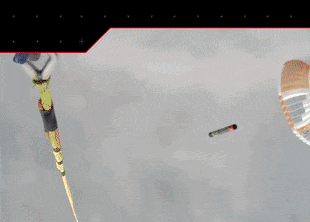The American company Rocket Lab for the first time caught the first stage of the Electron rocket using a helicopter after an orbital launch. After separation, the stage descended and released a parachute, and then the helicopter hooked it with a hook to lower the step onto a nearby vessel. If the state of the stage allows, it will be re-launched for the first time in one of the company's next missions. The launch was broadcast on the Rocket Lab YouTube channel.
Updated: the company said that after the helicopter caught the stage, the pilot found too much load and disconnected the stage. Then she was successfully brought down, and a vessel should lift her out of the water. In addition, the host of the broadcast noted that the stage is in excellent condition.
All launch vehicles, with the exception of the Falcon, are designed for one-time use, that is, all their components are destroyed after launch, or remain in space. The Falcon 9 and Falcon Heavy are partially reusable rockets in which the first stage and the head fairing can be gently returned to Earth and reused. The first stage lands on a sea platform or a cosmodrome, braking with rocket engines, and the fairing is driven by parachutes. This makes it possible to reuse the same components and significantly reduce the cost of launches and increase their frequency.
The Electron light rocket was originally designed as a one-time rocket, but in 2019 Rocket Lab decided to adapt its first stage so that it could be launched repeatedly. Unlike the Falcon, the Electron engineers decided not to use a jet landing, but a scheme in which the stage first reduces its speed using a parachute, and then a helicopter catches it in flight.
Since the end of 2020, the company has partially tested three times this scheme: after the launch, the stage released a parachute and descended, but the helicopter did not catch it in flight, so it was brought down. These tests allowed the engineers to check the behavior of the stage and its materials during entry into the dense layers of the atmosphere at high speed, and it is known that according to the results of the analysis they made changes to the design (probably they strengthened the thermal protection). The company also repeatedly [...] tested another part of the scheme: it caught a mass-dimensional model of the stage using a helicopter.
During the launch, which took place on May 3, Rocket Lab for the first time checked the entire scheme of the return of the first stage. At 1:50 Moscow time, a rocket with 34 small satellites from several companies took off from the cosmodrome on the Mahia Peninsula in New Zealand. After two and a half minutes, the stages separated and the second continued to launch the vehicles into a sun-synchronous orbit with a height of 520 kilometers, and the first began to return. It is assumed that during the descent, the stage accelerated to 2.3 kilometers per second and its individual parts warmed up to 2400 degrees Celsius. At an altitude of 13 kilometers, she released a braking parachute, and at 6 kilometers, the main one opened, whose task is to reduce the speed to 10 meters per second.
Shortly after, a Sikorsky S-92 helicopter flew up to the smoothly descending first stage, which was at the estimated crash site even before the launch. Flying up to the step, he managed to catch his rope with a hook at the end of the parachute rope. After that, the helicopter must deliver the step to a nearby service vessel and gently lower it onto it. In the future, she will be taken ashore.
It is important to understand that so far Rocket Lab has only managed to return the stage after launch. And although this is a serious engineering achievement in itself, it is equally important to check in practice whether it is possible to launch this first stage again.
There are other options for returning rocket parts after launch. So, the parachute scheme has already been used in the Space Shuttle, in which the side boosters descended on parachutes and fell into the water, and will also be used in the future Vulcan rocket, which will have only a block of engines descending on parachutes. Finally, there is a proposal to use a rotary wing instead of a jet landing or parachutes to land a step on the runway: This is how the first stage of the future Russian Irkut rocket should return to Earth. It is noteworthy that despite the unusual return scheme of the Electron first stage, the future Neutron Rocket Lab plans to use a proven method of jet landing.
Grigory Kopiev

